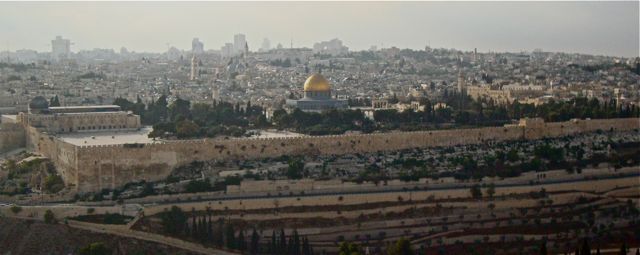
Last week a member of the Fatah Revolutionary Council kindly gave me a ride home from Ramallah to Jerusalem, and stopped at the Mount of Olives so my friend and I could see one of the best views of the Old City.
We told him we had wanted to visit the famous Dome of the Rock -- known to Jews as the Temple Mount site, known to Muslims as the Noble Sanctuary (Haram al-Sharif) -- but it was closed for security. A nice view was the best we could do.
 View of the Dome of the Rock from the Mount of Olives
View of the Dome of the Rock from the Mount of Olives
The previous day I had tried to enter the site but Israeli guards who control access to the area told me that unless I was a Muslim over 50-years-old, it wasn't going to happen.
Being a compulsive sightseer, I wrapped myself in a headscarf and walked to the next entry point. I tried to persuade the new set of guards that I did in fact qualify. I underestimated the seriousness of the situation, and unsurprisingly they were unamused.
The day before I went on an exhaustive tour of the Old City, that included an in-depth look at Jerusalem's architectural history, the Roman ruins, the Muslim quarter, the Byzantine churches, etc. We even went underground on a 1km walk through a narrow, ancient aqueduct with water up to our knees (which I highly recommend...this is the tunnel David is thought to have used to conquer Jerusalem).
We had an Israeli tour guide, who described the significance of the Dome of the Rock site: Jews believe the rock inside is the foundation stone, where God created the world in its present form and where Abraham was ready to sacrifice Isaac, while Muslims believe it is the spot from where the Prophet Muhammed ascended to heaven.
He also explained to us that the site was closed because a few days earlier Palestinians had thrown rocks at Jews who had entered the sacred area to pray. This is highly controversial and considered illegal to many, including Rabbi Elyashiv, a senior ultra orthodox leader.
Our friendly guide also added that wheelbarrows full of rocks had later been found near the al-Aqsa mosque, which were intended to throw at Jews worshiping on the Western Wall...literally a stone's throw away on the edge of the complex.
A day later, standing on the Mount of Olives, admiring the sunny golden dome, and its glistening mosaics, the same Fatah rep told us he witnessed this event first-hand --- and no rocks were thrown. He told us the instigators were six Jewish extremists who were breaking rules by coming to worship, and who were guarded by more than 20 Israeli guards at the time. He dismissed reports of the wheelbarrows (on a side note, he's a Christian).
Israeli police who responded to the event told the Associated Press that rocks were thrown by Palestinians at French tourists.
These disputed accounts capture the incredibly frustrating misinformation and slander that constantly comes from all sides in Jerusalem.
While the debate over the incident could be plausible, the debate it is seemingly grounded in is inexcusable: archaeology.
Israel, and the majority of contemporary archaeologists, believe that the Temple Mount is the site of the mighty Second Temple, which represents the high point of the Jewish Kingdom, some 2000 years ago. They say the Western Wall, which they visit today, was once part of Herod's ancient building.
From the Mount of Olives, our Fatah host denied this flat out. He insisted that "not a single stone proves the Second Temple was there."
We asked him where he thought it was then and he gestured about 100 meters to the side, in a non-committal way. Some Arabs nearby, who were also taking in the view, overheard his comment and aggressively agreed. They believed that Jewish visitors violated the site.
Such anger is nothing new. Nine years ago Ariel Sharon's visit to the holy area sparked the second intifada. This time around already dozens have been injured in subsequent protests, though yesterday the site re-opened.
Looking at the excavation site in-person, it's hard dispute the Israeli theory, but I don't know enough about archaeology, and I haven't found anything reasonable that uses science to discount it (please comment below if you have suggestions).
Either way, it seems that where a building stood 2000 years ago is a question of science, not faith, but it stokes such deep hatred that it clouds clear thinking.